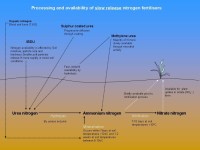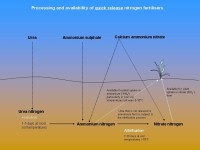Facts, Formulations & Fundamentals 2
 Facts, Formulations and Fundamentals - Part 2
Facts, Formulations and Fundamentals - Part 2
Part two of a series of three articles written by Kevin Timms Sports Turf Advisor NZ Sports Turf Institute on the Facts Formulations & Fundamentals of Fertilisers
Fertilisers and their use are at the core of successful, every-day turf management. Yet for many turf managers and prospective turf practitioners they remain somewhat of a mystery. Never before has the industry been so well served by such a myriad of products and formulations.
In order to make well informed decisions about the most appropriate option for any given situation it is first necessary to understand something about the "building blocks" or facts, formulations and fundamentals that define and govern the use of many of the fertiliser products available today:
Part 2.
- Burn potential of fertilisers
- Fertilisers I - O
- Nitrogen availability
When discussing or planning a fertiliser program, one frequently asked question is; "will it burn the turf"?
There are four factors to consider when determining the likely burn potential of a fertiliser:
1. Salt index
2. Solubility
3. Environmental conditions
4. Application technique
Salt index
The salt index of a fertiliser is a good indication of its potential for burning the turf. The salt index of a fertiliser does not predict the amount of fertiliser that will result in injury to turf, rather it classifies fertiliser formulations relative to Sodium Nitrate 100. The higher the number, the more likely it is to cause damage. Ammonium sulphate with a salt index of 88.3 and diammonium phosphate (D.A.P) at 29.2 are within the high burn potential range.
At the other end of the scale, superphosphate (7.8) and Lime (4.7) are examples of low salt index, low burn potential materials.
Solubility
Highly water soluble materials such as ammonium sulphate have a greater burn potential than many less water soluble materials. The risk is greatest with formulations that will readily dissolve.
Environmental conditions
As a rule of thumb, every effort should be made to avoid applying high burn potential fertilizers in hot conditions. An important point is to match the fertiliser formulation to the environmental conditions. A general rule of thumb is; 'wet- on-wet' and 'dry-on-dry'. In other words, apply dry fertilisers to a dry surface and liquid fertilisers to a wet surface.
Application technique
Poor application technique can turn even a moderate burn risk fertiliser into a real scorcher. Observation of the following basic rules will significantly reduce the risk of burn to your turf:
- Accurately calculate all areas and quantities
- Don't apply to stressed turf in hot conditions
- Apply during cooler times of the day
- Apply during rain or with follow-up irrigation
- Open the chute to release fertiliser on pedestrian or tractor-mounted spreaders at the start of each run after the spreader mechanism has been engaged and forward motion has commenced to prevent bulk 'dumping' of fertiliser.
- Don't rely on heavy dew alone to dissolve fertilisers, always apply follow-up irrigation.
Click on following link to view Fertiliser table : Facts and Fundamentals of Fertilisers
References
A & L Great Lakes Laboratories INC. (2002). Fact Sheet No. 15
Canberato, J.G. (2001).Nitrogen in soil and fertiliser, SC Turfgrass Foundation News, January-March, volume 8, number 1.
Nus, J. (1994).Slowly available nitrogen fertilisers, Golf Course Management, July edition
Ruscoe, P. (1994). Science of slow release fertilisers, Golf & Sports Turf Australia, April edition
Balance Agri-Nutrients. Nutrient handbook
Beggs, A. (1999), a Turf Managers guide to the nitrogen cycle. STRI, Bingley
Click on images to enlarge


Websites
www.nzsti.org.nz/
Article kindly provided by the The New Zealand Turf Managenent Journal
http://www.nzsti.org.nz/journal-subscription-back-issues.html
New Zealand Sports Turf Institute
163 Old West Road
PO Box 347
Palmerston North
NEW ZEALAND
